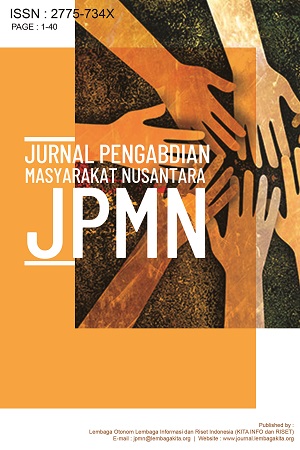Published: 2021-02-24
PELATIHAN PEMBUATAN VIDEO PEMBELAJARAN BERBASIS POWTOON SEBAGAI ALTERNATIF MEDIA PEMBELAJARAN PADA GURU SMP-TQ MU’ADZ BIN JABAL KENDARI
DOI: 10.35870/jpmn.v1i1.265
Amiruddin Takda, La Tahang, Luh Sukariasih, La Sahara, La Ode Nursalam
Article Metrics
- Views 0
- Downloads 0
- Scopus Citations
- Google Scholar
- Crossref Citations
- Semantic Scholar
- DataCite Metrics
-
If the link doesn't work, copy the DOI or article title for manual search (API Maintenance).
Abstract
Activities seek to improve the awareness and information of teachers about the role of educational media in Junior High School learning activities. Furthermore, this curriculum also teaches SMP TQ-Mu'adz Bin Jabal teachers to use the Powtoon technology to design and render instructional videos. Increasing teacher imagination in the creation and use of video learning media is the specific goal to be accomplished, so that science learning in schools can be more contextual. The method used in implementing this Community Service is counselling, training, and question and answer methods. This activity begins with observations in schools and related institutions/agencies in the first week, followed by core activities at SMP TQ-Mu'adz Bin Jabal Kendari. From the results of the dedication, it was found that: (1). This activity has been able to increase teacher knowledge about the urgency of instructional media and the development of forms of instructional media, especially those related to technological developments; (2) This activity has been able to improve the ability of teachers to operate computers or laptops, including in making online-based learning videos that are integrated into Powtoon.
Keywords
Powtoon ; Learning video ; Learning media ; Technology.
Article Metadata
Peer Review Process
This article has undergone a double-blind peer review process to ensure quality and impartiality.
Indexing Information
Discover where this journal is indexed at our indexing page to understand its reach and credibility.
Open Science Badges
This journal supports transparency in research and encourages authors to meet criteria for Open Science Badges by sharing data, materials, or preregistered studies.
How to Cite
Article Information
This article has been peer-reviewed and published in the Jurnal Pengabdian Masyarakat Nusantara (JPMN). The content is available under the terms of the Creative Commons Attribution 4.0 International License.
-
Issue: Vol. 1 No. 1 (2021)
-
Section: Articles
-
Published: %750 %e, %2021
-
License: CC BY 4.0
-
Copyright: © 2021 Authors
-
DOI: 10.35870/jpmn.v1i1.265
AI Research Hub
This article is indexed and available through various AI-powered research tools and citation platforms. Our AI Research Hub ensures that scholarly work is discoverable, accessible, and easily integrated into the global research ecosystem. By leveraging artificial intelligence for indexing, recommendation, and citation analysis, we enhance the visibility and impact of published research.




-
-
-
-
-
G. Abudllah and Yusuf Djafar, “Pelatihan Pembuatan Video Pembelajaran Menggunakan Aplikasi Camtasia Studio Berbasis Powerpoint Bagi Guru-Guru Sekolah Dasar Di Desa Sukamakmur Kecamatan Tolangohula Kabupaten Gorontalo,†Gorontalo, 2015. [Online]. Available: https://repository.ung.ac.id/abdi/show/1/894/pelatihan-pembuatan-video-pembelajaran-menggunakan-aplikasi-camtasia-studio-berbasis-powerpoint-bagi-guru-guru-sekolah-dasar-di-desa-sukamakmur-kecamatan-tolangohula-kabupaten-gorontalo.html.
-
-
-
-
-
-
-
-
C. & N. I. Semaan, “Effect of Using Powtoon on Learning English As a Foreign Language,†Int. J. Curr. Res., vol. 10, no. 05, pp. 69262–69265, 2018, [Online]. Available: https://www.journalcra.com/article/effect-using-powtoon-learning-english-foreign-language.
-
-

This work is licensed under a Creative Commons Attribution-NonCommercial-NoDerivatives 4.0 International License.
Authors who publish with this journal agree to the following terms:
1. Copyright Retention and Open Access License
Authors retain copyright of their work and grant the journal non-exclusive right of first publication under the Creative Commons Attribution 4.0 International License (CC BY 4.0).
This license allows unrestricted use, distribution, and reproduction in any medium, provided the original work is properly cited.
2. Rights Granted Under CC BY 4.0
Under this license, readers are free to:
- Share — copy and redistribute the material in any medium or format
- Adapt — remix, transform, and build upon the material for any purpose, including commercial use
- No additional restrictions — the licensor cannot revoke these freedoms as long as license terms are followed
3. Attribution Requirements
All uses must include:
- Proper citation of the original work
- Link to the Creative Commons license
- Indication if changes were made to the original work
- No suggestion that the licensor endorses the user or their use
4. Additional Distribution Rights
Authors may:
- Deposit the published version in institutional repositories
- Share through academic social networks
- Include in books, monographs, or other publications
- Post on personal or institutional websites
Requirement: All additional distributions must maintain the CC BY 4.0 license and proper attribution.
5. Self-Archiving and Pre-Print Sharing
Authors are encouraged to:
- Share pre-prints and post-prints online
- Deposit in subject-specific repositories (e.g., arXiv, bioRxiv)
- Engage in scholarly communication throughout the publication process
6. Open Access Commitment
This journal provides immediate open access to all content, supporting the global exchange of knowledge without financial, legal, or technical barriers.
